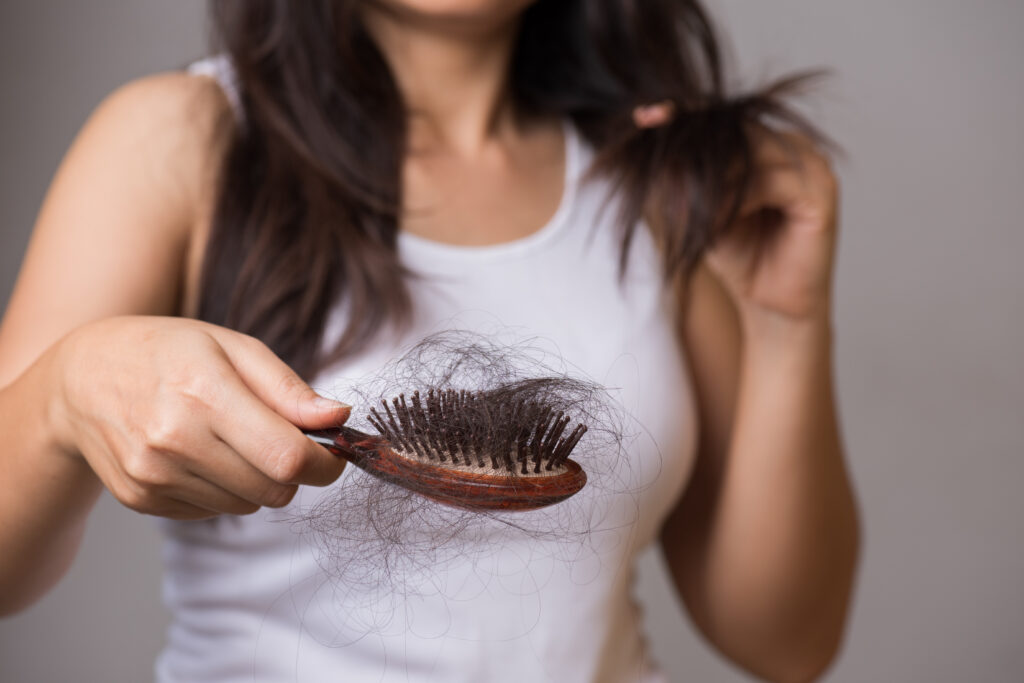Alopecia

What To Know About Hair Loss (Alopecia)
The word alopecia means hair loss. Alopecia develops when more hairs are being lost as compared to the number of hairs growing in. A large portion of the person’s scalp hair is continually growing. The growth cycle lasts approximately four years. At any one time, about one-tenth of the scalp hair first stops growing and then is lost. Hair loss of approximately 50 to 100 hairs a day is normal. When the hair is lost, new hairs start growing again from the same hair follicle.
Symptoms Of Alopecia
The most common form of alopecia is known as hereditary thinning or pattern alopecia and its cause is believed to be hormonal. This tendency may develop in males or females and is inherited from either the mother’s or the father’s side of the family. In males, pattern baldness is marked by hair loss over the top and front of the head and scalp. In females, thinning develops throughout the scalp but women do not usually become completely bald.
Causes Of Alopecia
There are many causes of hair loss including childbirth, severe illness with high fever, chronic illness, thyroid disease, insufficient protein in the diet, medications, low iron blood levels, fungus infection, alopecia areata, and improper hair care. Sometimes hair loss is an early sign of an underlying health problem.
Hair Loss After Childbirth
After childbirth, the normal cycle of hair loss and hair growth may be affected, so that many hairs enter the resting phase early and are lost without immediate replacement. This lasts about nine months and resolves on its own. Illnesses, especially those associated with high fevers may again affect the hair growth cycle and resolves on its own within a few months.
Hair Loss During Chronic Illness
The same effect may be seen during a chronic illness. Thyroid disease with either an overactive or an underactive thyroid affects the hair growth cycle and is corrected when the underlying thyroid condition is corrected. Dieting with insufficient protein and iron intake affects hair growth.
Why Alopecia Happens
Hair is mostly made up of protein. When the body does not have sufficient protein, more hairs enter the resting phase, are lost and the remaining hairs become more brittle. Low iron anemia is also related to hair loss. These conditions are corrected with sufficient protein and iron intake in the diet. Many medications, such as those used for birth control and a variety of ailments including high blood pressure, heart disease, arthritis, and cancer may cause temporary hair loss.
In alopecia areata, hair loss appears suddenly without symptoms in the form of round bald patches most often on the scalp. Often it is discovered during a haircut. The hair simply stops growing and starts falling out from the roots.
Alopecia areata is classified as an autoimmune disorder. With alopecia areata, the hair usually grows back by itself after a prolonged and unpredictable period of time. Sometimes it grows in gray or white, but after a while the original color usually returns. Other autoimmune diseases such as lupus erythematosus may also cause hair loss.
Improper hair care with the use of strong chemicals and straighteners may cause hair to weaken and break. This condition is reversible with discontinuation of the damaging agent.
Diagnosis
Dermatologists are skilled in diagnosing different types of hair loss by sight alone. In rare instances, they may perform a skin biopsy at the affected area, so it can be examined under a microscope. Hair loss that is diagnosed as being caused by systemic disease will require an extensive evaluation and specific tests to properly identify the problem.
Treatments for Alopecia
Proper treatment for the underlying cause of hair loss may restore hair growth. It is important to see a dermatologist early on to identify the type of hair loss and to start a course of treatment. Other treatments include topical treatment or oral therapies such as Propecia and Minoxidil.
There are also very safe and effective hair restoration methods available. They can consist of simply weaving and blending in someone else’s hair, to surgically transplanting hair follicles from another part of the scalp to the affected area. Depending on the type of hair loss, a combination of medical and surgical treatments can be very effective.
We offer laser therapy for scalp stimulation to support hair regrowth. This highly specialized treatment uses a laser to create tiny “micro-channels” in the scalp. These microchannels increase absorption of compounds that promote hair regrowth, making it a viable medical alopecia treatment option for many people.
Long Term Prognosis
The outcome of this condition depends on what is causing the hair loss. It is important to seek treatment early on so a cause can be identified and a treatment plan to slow down and/or correct the condition can be developed.
Service Available at the Following Locations
Healthy Skin Starts With Us
